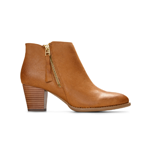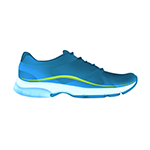
Why Do My Feet Swell When I Travel?

There’s nothing quite like the feeling of jet-setting to a new location. Whether you’re in a new city or across the ocean, you want to feel your best when you arrive at your destination. However, if you’re an avid traveler, you may already be familiar with one of the most common bodily responses to these exciting excursions: foot swelling. If you’ve ever wondered, “Why do my feet and ankles swell when I travel?” you’re not alone.
Read on to learn more about the effects of air travel on foot swelling, the impact of dehydration, and whether footwear can help prevent it so you’re prepared before your next adventure.
What Are the Effects of Air Travel on Foot Swelling?
If you usually untie your laces or take off your shoes during a long flight, you’re probably familiar with the oh-so-snug feeling of pulling your shoes back on before you deboard. So why does it seem like your feet grew two sizes mid-air?
Foot and leg swelling during air travel, also called dependent edema, is pretty common and is usually the result of a lack of movement for any long period. When you’re on a plane, you’re probably walking and moving significantly less than you do during your everyday life. This can cause blood to pool in your veins around your ankles and feet, causing swelling and sometimes mild discomfort. This fluid buildup can cause a lack of blood circulation, also leading to lower leg swelling.
Salty plane snacks like peanuts and pretzels may be another culprit causing mid-flight foot swelling, especially if you’re sensitive to sodium. When you’re on a plane, it’s a good idea to opt for nutrient-dense foods and stay as active as possible to prevent ankle swelling or leg pain.
When Does Dehydration Cause Foot Swelling While Traveling?
If you’ve ever wondered, “Why do my feet swell when I travel?” you may be dehydrated. When you’re dehydrated, your blood can become thicker, slowing down blood circulation, which causes swelling.
While swelling during travel is fairly typical and usually harmless, poor blood circulation can have more serious consequences, leading to the development of blood clots, which can cause other symptoms and conditions. Here are some tips to help you maintain proper circulation during your travels:
- Don’t cross your legs or feet.
- Try to move and stretch your feet while sitting.
- Keep as much room under the seat in front of you as possible by putting your carry-on or personal item in the overhead compartment or packing a small bag.
- Stand, walk, and exercise your legs whenever you can.
- Wear the proper travel footwear.
Although it’s tough to reduce foot swelling while traveling, keeping these tips in mind can help you boost your circulation and prevent significant swelling and discomfort.
Who Is Most Susceptible to Foot Swelling While Traveling?
While most passengers who travel by plane may experience some foot and leg swelling, especially those on flights that are seven hours or longer, there are certain people who may be more susceptible to these symptoms. Understanding whether you’re more at risk for foot swelling while traveling can allow you to plan ahead and take preventative steps.
You may be more likely to experience foot swelling from inactivity if you have diabetes or if you’re pregnant. You may also notice swelling faster than other passengers if you didn’t properly hydrate before and during your travel or if you’ve eaten a lot of salty snacks and are particularly sensitive to sodium intake.
Can Your Feet Also Swell When Traveling by Car?
You may already be used to dealing with foot swelling when traveling by plane, but it’s also not uncommon to experience this while on a road trip. If you’ve ever wondered, “Why do my feet swell when I travel by car?” then you know just how common it is. Many of the causes of your discomfort in a car are the same as when you’re on a long flight.
Several hours of sitting in the same position can lead to swelling, whether you’re on the road or in the air. If you’re a passenger, you may be more likely to sit cross-legged on a road trip, which can also make you more susceptible to swelling.
Fortunately, you’re able to take breaks and step outside of the vehicle when traveling by car, so it’s important to schedule rest stops to help prevent foot and leg swelling. Besides stopping for a bathroom break or to buy more road trip snacks, take time to stretch your limbs before getting back on the road.
What Are the Long-Term Effects of Travel-Induced Foot Swelling?
Fortunately, there aren’t serious side effects or long-term consequences for mild travel-induced foot swelling. However, for some people, foot swelling can be a sign of a more serious condition: deep vein thrombosis (DVT). DVT occurs when you have a blood clot deep in your muscle.
Here are some symptoms to look out for if you’re concerned about developing DVT:
- Your foot or leg looks red or feels hot
- One foot is more swollen than the other
- Your swelling doesn’t go away a few hours after deboarding the plane
- You have pain and tenderness in addition to swelling
If you’re predisposed to blood clots, make a travel plan with your healthcare provider to ensure you stay safe and comfortable during your journey. They may suggest blood thinners or compression socks to ensure you maintain healthy circulation for the duration of the flight or road trip.
What Role Does Footwear Play in Preventing Travel-Related Foot Swelling?
If you’ve ever thought, “Why do my feet swell while traveling?” you may be wearing the wrong footwear. One way to steer clear of unwanted swelling while you travel is to wear breathable, comfortable footwear for traveling. Foot health is connected to your body’s overall well-being, so prioritizing your feet while you travel can help you feel better overall.
Comfortable athletic shoes are smart options since their laces allow you to adjust the tightness during your journey. If these shoes aren’t your style, there are plenty of other footwear options to consider. Regardless of the shoes or boots you like, the most important factor to keep in mind is whether the toe box is roomy enough for you to move and wiggle your toes while wearing socks.
Slip-on shoes, like the Uptown Loafer, are another common travel-day style, as they make it easy to take off your shoes and massage your feet, which can promote circulation and help minimize swelling when you’re sitting for a long period.
Tips for Preventing Foot Swelling While On a Flight
When you want to avoid uncomfortable foot swelling during travel, there are several steps you can take before and during your flight. Here are some ways you can set yourself up for a comfortable travel day.
Pack Your Own Food
If you know you’re going on a flight that’s more than four hours long, consider bringing your own nutrient-dense foods and snacks. Plane food, especially the snack bags that airlines distribute, can be packed with sodium, increasing the likelihood that your feet and ankles will swell.
Instead, pack snacks that provide you with the vitamins and nutrients your body needs to make it through a travel day. Dried fruit, unsalted nuts, veggies and dip, and protein bars are all relatively convenient and packable plane snacks.
Pick a Few Helpful Stretches
While it may not be possible to complete an entire yoga session mid-flight, consider trying a few leg and foot health exercises you know you’ll be able to do on the plane before you board or while seated. This can include ankle rolls, calf stretches, flexing and pointing your foot, and other forms of light movement that promote proper blood flow and circulation.
If possible, try to reserve an aisle seat so it’s easier for you to take quick walking breaks up and down the aisle every hour or so. This can also give you more room to stretch your legs and feet during the flight.
Opt for Comfortable Footwear
When choosing the best travel shoes for your feet, make sure to select footwear that’s comfortable and allows your feet—and especially toes—to move and breathe.
Tight footwear can restrict the blood flow to your feet, leading to more swelling and discomfort when you travel. Comfortable, slip-on shoes, like the Uptown Knit Skimmer Flat, are ideal for travel, whether driving or flying to your destination.
Stay Comfortable and Stylish When You Travel with Vionic
Whether you’re hitting the open road or boarding a plane, finding the right travel footwear is crucial. Not only can this help keep you comfortable during your journey, but it can help to ensure you minimize swelling and promote proper circulation.
When you’re searching for footwear for your next adventure, you won’t have to sacrifice style for the sake of comfort with the help of Vionic. We factor arch support, cushioning, and style into all of our travel shoes for women. You’ll find our cutting-edge Vio-Motion Technology in a variety of our footwear options, allowing you to prioritize your foot health while showcasing your personal fashion sense.
Look and feel your best while traveling when you wear Vionic.
Sources:
Coastal Podiatry Associates. How To Avoid Swollen Feet During Holiday Travel. https://www.coastalpodiatry.com/blog/how-to-avoid-swollen-feet-during-holiday-travel.cfm
Everyday Health. 10 Ways to Avoid Swollen Feet and Ankles During Travel. https://www.everydayhealth.com/foot-health/prevent-swollen-feet-during-travel.aspx
Optima Foot and Ankle. Is Foot Swelling During Air Travel a Concern? https://www.optimafootandankle.com/blog/is-foot-swelling-during-air-travel-a-concern









